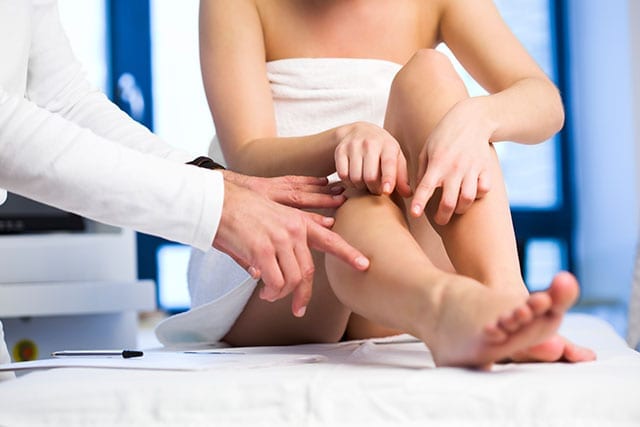Reasons Spider Veins Appear
There are a number of reasons you may be seeing spider veins. It could be one or a number of these factors:
- Heredity – Having a family member with prominent veins may increase your risk of developing them. Approximately half of the people who get these veins have a family history of them.
- Age – The normal wear and tear of aging may cause valves in the veins to weaken and not work as well.
- Gender – Women are two to three times more likely to develop spider veins than men. Up to half of American women have these veins. Changes in hormones due to puberty, pregnancy, menopause, or taking birth control pills may increase a woman’s risk of developing varicose veins.
- During pregnancy, the growth of the fetus increases the pressure on the veins in the legs. Spider veins that occur during pregnancy usually improve within 3 to 12 months following delivery.
- Overweight and obesity. Having extra weight on the body can put additional pressure on the veins.
- Prolonged standing or sitting. This is particularly true with legs bent or crossed. When standing or sitting with legs bent or crossed, the veins have to work harder to pump the blood up to the heart.
How To Treat Spider Veins
There are effective, safe and relatively painless methods available for reducing spider veins. First consult with a physician, either a dermatologist or vascular surgeon, who will evaluate your general health status and any pre-existing health conditions or risk factors and examine your veins in detail. Your doctor will discuss likely outcomes of spider vein treatment and any risks or potential complications. After you discuss your options, your surgeon will recommend a course of treatment.
The best treatment option for treating spider veins is sclerotherapy. Sclerotherapy is a procedure in which a solution is injected into the veins, collapsing them. The total treatment time is usually between 15-45 minutes. It may take a few injections for the veins to completely disappear, separated 4-6 weeks apart.
What To Expect After Treatment
Within the first week, the treated sites will appear bruised. You may be instructed to wear support stockings for three to six weeks. The treated sites will appear bruised and you may feel some cramping in your legs for the first day or two after treatment. This discomfort is temporary and usually doesn’t require prescription medication. You should avoid squatting, heavy lifting and running, and you will be discouraged from sitting or standing in one place for more than an hour or two. Although every person heals at a different rate, most are back to normal activities quickly.
Within one month, the bruises at the treated sites will diminish and you can resume most exercise. The spider veins will appear lighter, but may still be visible. After two months, your veins treatment should have completed its healing. At this point, you and your doctor will decide if any additional treatment is necessary.
After each spider vein treatment, you will notice improvement of your skin’s appearance. However, it is important to realize that new spider veins may surface in the future. As time passes, you may want to consider further treatment to take care of any new veins that may emerge. Be sure to discuss with your surgeon the results expected in your case, as well as the cost involved.
At our dermatology offices, dermatologist Dr. Kenneth Egan specializes in all family’s skin care needs in general medical, surgical and cosmetic dermatology including skin cancer, acne, eczema, warts, moles, fungal nail infections, rashes and scars. Our offices are located in the Fairfield County, CT towns of Danbury, Norwalk and Ridgefield.

